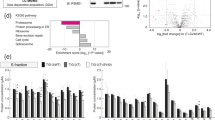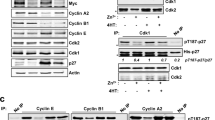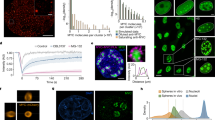Abstract
The c-Myc oncoprotein regulates transcription of genes that are associated with cell growth, proliferation and apoptosis1. c-Myc levels are modulated by ubiquitin/proteasome-mediated degradation1. Proteasome inhibition leads to c-Myc accumulation within nucleoli2, indicating that c-Myc might have a nucleolar function. Here we show that the proteins c-Myc and Max interact in nucleoli and are associated with ribosomal DNA. This association is increased upon activation of quiescent cells and is followed by recruitment of the Myc cofactor TRRAP, enhanced histone acetylation, recruitment of RNA polymerase I (Pol I), and activation of rDNA transcription. Using small interfering RNAs (siRNAs) against c-Myc and an inhibitor of Myc–Max interactions, we demonstrate that c-Myc is required for activating rDNA transcription in response to mitogenic signals. Furthermore, using the ligand-activated MycER (ER, oestrogen receptor) system, we show that c-Myc can activate Pol I transcription in the absence of Pol II transcription. These results suggest that c-Myc coordinates the activity of all three nuclear RNA polymerases, and thereby plays a key role in regulating ribosome biogenesis and cell growth.
This is a preview of subscription content, access via your institution
Access options
Subscribe to this journal
Receive 12 print issues and online access
$209.00 per year
only $17.42 per issue
Buy this article
- Purchase on Springer Link
- Instant access to full article PDF
Prices may be subject to local taxes which are calculated during checkout





Similar content being viewed by others
References
Oster, S. K., Ho, C. S., Soucie, E. L. & Penn, L. Z. The myc oncogene: MarvelouslY Complex. Adv. Cancer Res. 84, 81–154 (2002).
Arabi, A., Rustum, C., Hallberg, E. & Wright, A. P. Accumulation of c-Myc and proteasomes at the nucleoli of cells containing elevated c-Myc protein levels. J. Cell Sci. 116, 1707–1717 (2003).
McMahon, S. B., Wood, M. A. & Cole, M. D. The essential cofactor TRRAP recruits the histone acetyltransferase hGCN5 to c-Myc. Mol. Cell. Biol. 20, 556–562 (2000).
Frank, S. R. et al. MYC recruits the TIP60 histone acetyltransferase complex to chromatin. EMBO Rep. 4, 575–580 (2003).
Johnston, L. A., Prober, D. A., Edgar, B. A., Eisenman, R. N. & Gallant, P. Drosophila myc regulates cellular growth during development. Cell 98, 779–790 (1999).
Schuhmacher, M. et al. Control of cell growth by c-Myc in the absence of cell division. Curr. Biol. 9, 1255–1258 (1999).
Ruggero, D. & Pandolfi, P. P. Does the ribosome translate cancer? Nature Rev. Cancer 3, 179–192 (2003).
Gomez-Roman, N., Grandori, C., Eisenman, R. N. & White, R. J. Direct activation of RNA polymerase III transcription by c-Myc. Nature 421, 290–294 (2003).
Poortinga, G. et al. MAD1 and c-MYC regulate UBF and rDNA transcription during granulocyte differentiation. EMBO J. 23, 3325–3335 (2004).
Schlosser, I. et al. A role for c-Myc in the regulation of ribosomal RNA processing. Nucleic Acids Res. 31, 6148–6156 (2003).
Salghetti, S. E., Kim, S. Y. & Tansey, W. P. Destruction of Myc by ubiquitin-mediated proteolysis: cancer-associated and transforming mutations stabilize Myc. EMBO J. 18, 717–726 (1999).
Flinn, E. M., Busch, C. M. & Wright, A. P. myc boxes, which are conserved in myc family proteins, are signals for protein degradation via the proteasome. Mol. Cell. Biol. 18, 5961–5969 (1998).
Kim, S. Y., Herbst, A., Tworkowski, K. A., Salghetti, S. E. & Tansey, W. P. Skp2 regulates Myc protein stability and activity. Mol. Cell 11, 1177–1188 (2003).
von der Lehr, N. et al. The F-box protein Skp2 participates in c-Myc proteosomal degradation and acts as a cofactor for c-Myc-regulated transcription. Mol. Cell 11, 1189–1200 (2003).
Welcker, M. et al. The Fbw7 tumor suppressor regulates glycogen synthase kinase 3 phosphorylation-dependent c-Myc protein degradation. Proc. Natl Acad. Sci. USA 101, 9085–9090 (2004).
Yada, M. et al. Phosphorylation-dependent degradation of c-Myc is mediated by the F-box protein Fbw7. EMBO J. 23, 2116–2125 (2004).
Visintin, R. & Amon, A. The nucleolus: the magician's hat for cell cycle tricks. Curr. Opin. Cell Biol. 12, 752 (2000).
Grinberg, A. V., Hu, C. D. & Kerppola, T. K. Visualization of Myc/Max/Mad family dimers and the competition for dimerization in living cells. Mol. Cell. Biol. 24, 4294–4308 (2004).
O'Sullivan, A. C., Sullivan, G. J. & McStay, B. UBF binding in vivo is not restricted to regulatory sequences within the vertebrate ribosomal DNA repeat. Mol. Cell. Biol. 22, 657–668 (2002).
Santoro, R., Li, J. & Grummt, I. The nucleolar remodeling complex NoRC mediates heterochromatin formation and silencing of ribosomal gene transcription. Nature Genet. 32, 393–396 (2002).
Mutskov, V. J., Russanova, V. R., Dimitrov, S. I. & Pashev, I. G. Histones associated with non-nucleosomal rat ribosomal genes are acetylated while those bound to nucleosome-organized gene copies are not. J. Biol. Chem. 271, 11852–11857 (1996).
Yin, X., Giap, C., Lazo, J. S. & Prochownik, E. V. Low molecular weight inhibitors of Myc-Max interaction and function. Oncogene 22, 6151–6159 (2003).
Grummt, I. Life on a planet of its own: regulation of RNA polymerase I transcription in the nucleolus. Genes Dev. 17, 1691–1702 (2003).
Frank, S. R., Schroeder, M., Fernandez, P., Taubert, S. & Amati, B. Binding of c-Myc to chromatin mediates mitogen-induced acetylation of histone H4 and gene activation. Genes Dev. 15, 2069–2082 (2001).
Halkidou, K., Logan, I. R., Cook, S., Neal, D. E. & Robson, C. N. Putative involvement of the histone acetyltransferase Tip60 in ribosomal gene transcription. Nucleic Acids Res. 32, 1654–1665 (2004).
Koberna, K. et al. Ribosomal genes in focus: new transcripts label the dense fibrillar components and form clusters indicative of “Christmas trees” in situ. J. Cell Biol. 157, 743–748 (2002).
Elbashir, S. M. et al. Duplexes of 21-nucleotide RNAs mediate RNA interference in cultured mammalian cells. Nature 411, 494–498 (2001).
Seither, P. & Grummt, I. Molecular cloning of RPA2, the gene encoding the second largest subunit of mouse RNA polymerase I. Genomics 37, 135–139 (1996).
Boyd, K. E., Wells, J., Gutman, J., Bartley, S. M. & Farnham, P. J. c-Myc target gene specificity is determined by a post-DNAbinding mechanism. Proc. Natl Acad. Sci. USA 95, 13887–13892 (1998).
Cheutin, T. et al. Three-dimensional organization of active rRNA genes within the nucleolus. J. Cell Sci. 115, 3297–3307 (2002).
Acknowledgements
We thank J. Sylvester for providing the rDNA FISH probe, T. Kerppola for providing the BiFC vectors, A. Tikhonenko for providing the chicken c-Myc vector, M. Eilers for providing the Rat1- and U2OS-MycER cell lines, and B. Edgar, R. Eisenman, C. Grandori and R. White for communicating results prior to publication. We also would like to thank F. Godeau and P. Thuriaux for creative discussions. The work was supported by grants from the Swedish Cancer Society to A.W. and L.-G.L. and from the Swedish Children Cancer Foundation, Agrifungen and the Human Frontier Science Program (HFSP) to L.-G.L. I. G. was supported by the Deutsche Forschungsgemeinschaft and the Fonds der Chemischen Industrie. A.W. is a senior investigator supported by the Swedish Research Council.
Author information
Authors and Affiliations
Corresponding author
Ethics declarations
Competing interests
The authors declare no competing financial interests.
Rights and permissions
About this article
Cite this article
Arabi, A., Wu, S., Ridderstråle, K. et al. c-Myc associates with ribosomal DNA and activates RNA polymerase I transcription. Nat Cell Biol 7, 303–310 (2005). https://doi.org/10.1038/ncb1225
Received:
Accepted:
Published:
Issue Date:
DOI: https://doi.org/10.1038/ncb1225
This article is cited by
-
STAT3 potentiates RNA polymerase I-directed transcription and tumor growth by activating RPA34 expression
British Journal of Cancer (2023)
-
Altered vitamin B12 metabolism in the central nervous system is associated with the modification of ribosomal gene expression: new insights from comparative RNA dataset analysis
Functional & Integrative Genomics (2023)
-
MYC sensitises cells to apoptosis by driving energetic demand
Nature Communications (2022)
-
Plantar mechanical stimulation attenuates protein synthesis decline in disused skeletal muscle via modulation of nitric oxide level
Scientific Reports (2021)
-
The emerging role of NOTCH target genes in Egyptian childhood acute lymphoblastic leukemia
memo - Magazine of European Medical Oncology (2021)



